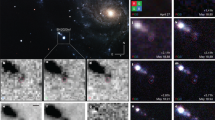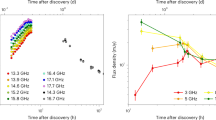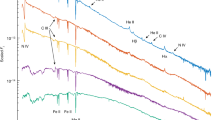Abstract
Observations at Australian observatories1 showed that radio emission from SN1987A in the Large Magellanic Cloud2 reached a peak of ~100 mJy at frequencies of ~ 1 GHz within three days of the optical rise and then declined on a similar timescale. This behaviour is different from that observed from previous extragalactic type II radio supernovae3 where the peak luminosity is two to three orders of magnitude greater and the emission rises tens or even hundreds of days after the supernova event and then decays with a timescale of years. Here we propose that the radio emission mechanism for SN1987A is the same as that proposed for previous type II supernova4, namely, synchrotron emission from a thin shell near the edge of the expanding ejecta. The differences are mainly due to the absence of a thick circumstellar envelope around the progenitor star, Sk –69 202, at least in the line of sight to the supernova. We discuss several possible models for the emission and absorption processes and set limits on the density of a circumstellar envelope.
This is a preview of subscription content, access via your institution
Access options
Subscribe to this journal
Receive 51 print issues and online access
$199.00 per year
only $3.90 per issue
Buy this article
- Purchase on Springer Link
- Instant access to full article PDF
Prices may be subject to local taxes which are calculated during checkout
Similar content being viewed by others
References
Turtle, A. J. et al. Nature 327, 38–40 (1987).
Shelton, I. IAU Circ. No. 4316 (1987).
Weiler, K. W., Sramek, R. A., Panagia, N., van der Hulst, J. M. & Salvati, M. Astrophys. J. 301, 790–812 (1986).
Chevalier, R. A. Astrophys. J. 259, 302–310 (1982).
Blandford, R. D. & Eichler, D. Phys. Rep. (in the press).
Ginzburg, V. L. & Syrovatskii, S. I. A. Rev. Astr. Astrophys. 3, 297–350 (1965).
Gilmozzi, R. et al. Nature 328, 318–320 (1987).
Danziger, I. J. et al. Astr. Astrophys. 117, L13–L16 (1987).
Vidal-Madjar, A. et al. Astr. Astrophys. 177, L17–L20 (1987).
Rybicki, G. B. & Lightman, A. P. Radiative Processes in Astrophysics (Wiley, New York 1979).
Landstreet, J. D. Astrophys. J. 258, 639–650 (1982).
Koshiba, M. IAU Circ. No. 4338 (1987).
Svoboda, R. IAU Circ. No. 4340 (1987).
Author information
Authors and Affiliations
Rights and permissions
About this article
Cite this article
Storey , M., Manchester, R. Modelling of the radio burst from SN1987A. Nature 329, 421–423 (1987). https://doi.org/10.1038/329421a0
Received:
Accepted:
Issue Date:
DOI: https://doi.org/10.1038/329421a0
This article is cited by
-
Radio emission from supernova remnants
The Astronomy and Astrophysics Review (2015)
-
A model for the radio brightness of the supernova remnant 1987A
Nature (1992)
Comments
By submitting a comment you agree to abide by our Terms and Community Guidelines. If you find something abusive or that does not comply with our terms or guidelines please flag it as inappropriate.



